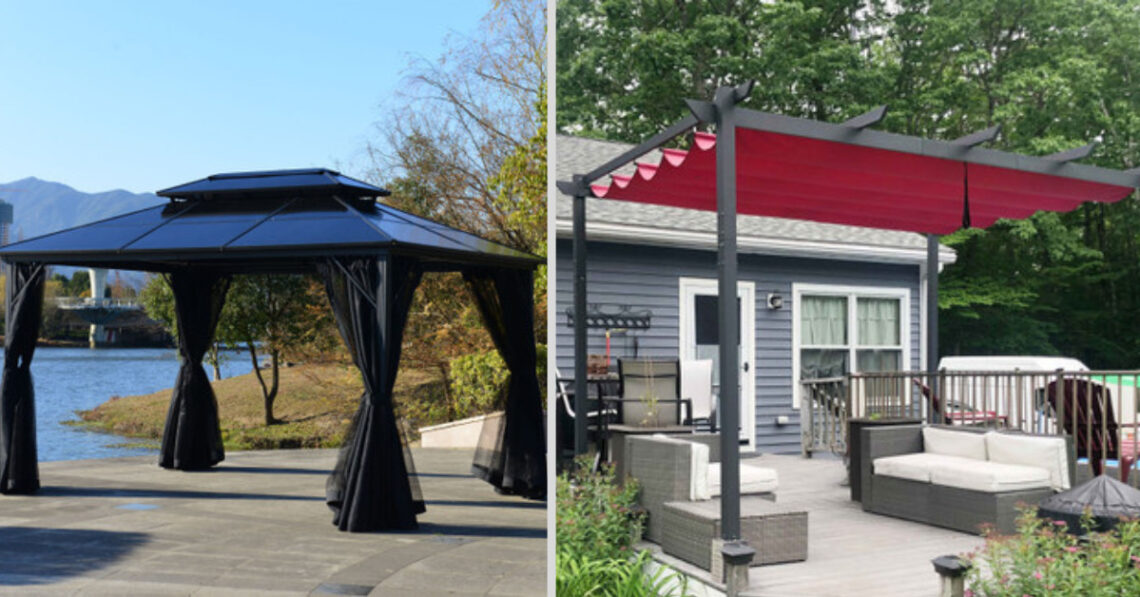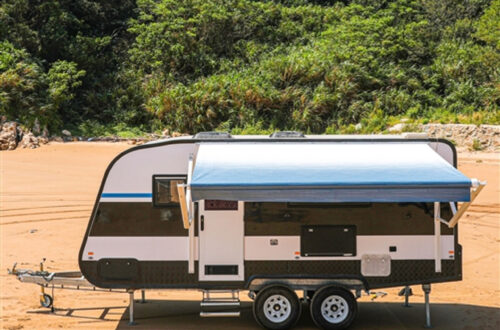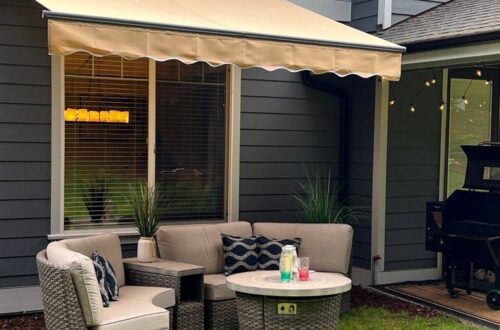If you want a simple yet attractive way to add shade and style to your yard space, you have two main options: a pergola or a gazebo. But what is the difference between a gazebo and a pergola? And which outdoor structure is right for you?
If the question of pergola vs gazebo has been on your mind, you’re in the right place.
We’ve put together an overview of the key differences between the two garden structures, along with tips on choosing the right one for your home. Whether you’re looking for a place to relax in the shade, hang out by the barbecue, or entertain guests, here’s everything you need to know about pergolas and gazebos.
Key Differences Between Pergolas and Gazebos
Pergolas and gazebos are both structures that can provide shade and be used for outdoor living spaces. To make matters more confusing, people often use the terms pergola and gazebo interchangeably. However, these two garden features have some notable differences.
#1 Open Roof vs. Solid Roof
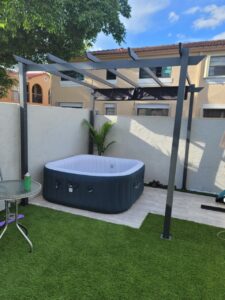
If you’re uncertain which kind of structure you’re looking at, the most obvious difference is the roof style.
- Pergolas – Look for an open roof that’s constructed of a framework or lattice which allows in light and free circulation of air. The pergola roof framework may be constructed of wooden beams or aluminum slats, PVC pipes, or other materials.
- Gazebos – Look for a closed roof that provides more shelter from sun and rain. The roof may be constructed of wood, metal, or a replaceable fabric cover placed over a metal frame.
#2 Freestanding vs. Attached to the Home
Gazebos are always freestanding structures that stand completely independent of the home. They are often located in the garden to provide a charming landscape enhancement, or on a deck or patio to provide shaded seating.
Pergolas are often freestanding, but they can also be constructed so that they are attached to the home on one side. In this type of installation, the pergola extends out from an exterior wall much like a porch roof. The other end is supported by posts or pillars. The roof of the pergola is still an open framework that allows in sun and air.
#3 Open vs. Closed Sides
Both pergolas and gazebos are open, airy structures without solid walls. Pergolas typically don’t have any sort of side enclosure.
Gazebos often have partially enclosed sides to offer a bit more privacy and protection from the elements. On a traditional wooden gazebo, side enclosures are often low railings or latticework. On more modern steel, PVC, or vinyl gazebos, the sides are often fully enclosed with screens or curtains to keep out bugs, add privacy, and offer UV protection.
#4 Square Footprint vs. Circular or Hexagonal
Traditionally, gazebos were constructed in a circular or hexagonal footprint and often featured a cupola or pagoda-style roof. Modern gazebos may be circular or hexagonal in the classic style, or have a more simplified square layout.
Pergolas, on the other hand, are almost always constructed in a square or rectangular footprint, with four posts or pillars supporting the roof framework.
Should You Choose a Pergola or Gazebo?
When you’re weighing your options in the gazebo vs pergola debate, there are several factors to consider. The most important are appearance, function, and cost. Let’s take a closer look at each one.
- Appearance – Pergolas are typically simpler, with only four posts and an open slat roof. They may or may not have a fabric canopy to add a bit of shade. Gazebos may have a more ornate appearance thanks to their finished roof, which is often embellished with details like a curved roofline or a cupola. However, both can be decorated with personal touches like hanging lanterns, Edison lights, vining plants, and hanging planters.
- Function – Do pergolas provide shade with their open roof design? Pergolas provide partial shade and can be used as an outdoor living space or as an extension of your indoor living space. They are often located over a walkway or set up on a patio, where they make an ideal trellis for vining plants. Gazebos provide full shade and are often used as an outdoor kitchen, a hot tub enclosure, or create a seating area. The full roof makes them the best choice for providing shelter from the elements.
- Cost – Curious about how the cost of gazebo structures compares to the cost of a pergola? Pergolas are typically less expensive than gazebos due to their simpler design. However, both structures can be costly depending on the materials used and the size of the structure. Ready-made gazebos and pergolas are more affordable options, and can be just as beautiful and functional as custom options.
Where to Place Pergolas and Gazebos
Choosing the location for your pergola or gazebo is key to making sure you get the most possible use out of your new outdoor feature. How you’ll use the structure, sun exposure, privacy, and the surrounding landscape should be your primary considerations.
#1 Purpose of Your Pergola or Gazebo
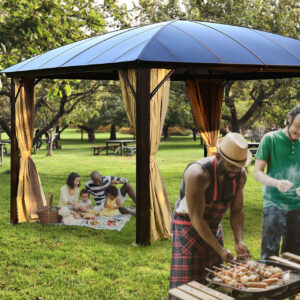
Do you envision yourself entertaining guests in your new gazebo? Relaxing alone with a good book and a glass of iced tea? Or is your pergola simply a decorative element in your backyard where you’ll grow flowering vines? The purpose of the structure will help determine the best location.
- Outdoor entertaining – If your pergola or gazebo will mostly be used for outdoor dining, place it on a patio or deck nearest your kitchen door. This will make it more convenient to transport food and dishes from the kitchen to the outdoor space.
- Private retreat – If you’re looking to create a garden relaxation area, consider placing your structure in a secluded spot in your backyard, away from the noise of the street or neighbors.
#2 Size of Your Yard
If you have a small backyard, you may need to be more creative in finding the right location for a pergola or gazebo. Consider using a corner of your yard or placing the structure against a wall.
On the other hand, if you have a larger backyard, you’ll have more options. You may wish to place the structure in the center of your yard, creating a focal point for your outdoor space.
#3 Sun Exposure and Shade
One of the most critical factors to take into account when selecting the location of your pergola or gazebo is the sun exposure and shade in your backyard. Think about the time of day you’re most likely to use the structure and the angle of the sun during that time. It’s a good idea to spend some time in your yard before installing your structure, noting which areas are in shade at different times of the day.
- For afternoon use – Consider placing it in a shaded area to avoid direct sunlight, which may make the space too hot for comfort.
- For morning use – If you’re planning to use the structure earlier in the day, you may want to choose a location with more sun exposure so you can warm up and soak in the morning rays.
#4 Surrounding Landscape
If you’ll be placing your gazebo or pergola in your yard instead of on a deck or patio, be sure to take into account how the terrain of the yard will affect placement. Consider the topography of your yard, areas where tree roots might make leveling difficult, landscaping features, and views.
- If your yard is uneven, you’ll need to grade an area to make a level footing for your structure.
- If you have a sloped yard, you may want to place your gazebo at the top of the slope to command the best views of your garden.
- If you have trees, a pond, or other special features, you may want to place the structure nearby to create a visually cohesive outdoor space.
#5 Privacy
Finally, take into account the level of privacy you want in your outdoor space. If you live in a densely populated area, you may want to choose a location that’s more secluded to create an outdoor retreat.
- Try placing the structure against a wall or fence.
- Create a natural barrier using trees, shrubs, or fast-growing vines like sweet peas trained up a trellis.
- Add curtains or screens to the structure—these can be closed when you want privacy, or opened when you’re using the space for entertaining.
Beautify Your Landscape with ALEKO
So, what is the difference between a pergola and a gazebo? It mostly comes down to roof style and whether you’re looking for solid protection from rain and sun, or breezy partial shade. Whichever you choose, your new outdoor feature will help create an inviting outdoor space to enjoy year-round. These simple structures are not just functional, but also add style and value to your property.
While the options can seem overwhelming, choosing a ready-made pergola or gazebo from ALEKO will ensure that you get a quality piece that will last for years to come.
At ALEKO, we take pride in manufacturing high-quality outdoor furnishings that are built to last, using durable materials and classic designs. We can help you reimagine your garden and create a stunning oasis that you’ll love spending time in. Contact us today, and let’s start building your dream outdoor space together.
Sources:
Bob Vila. The difference between a pergola and gazebo, explained. https://www.bobvila.com/articles/pergola-vs-gazebo/
This Old House. How to build a great gazebo. https://www.thisoldhouse.com/yards/21015401/building-a-great-gazebo

